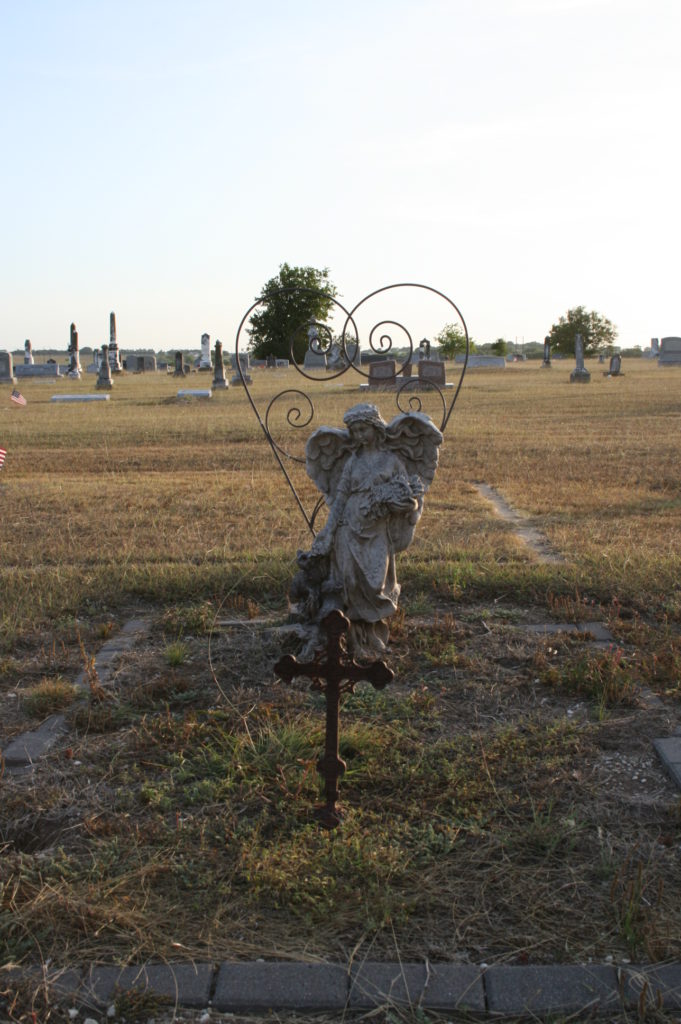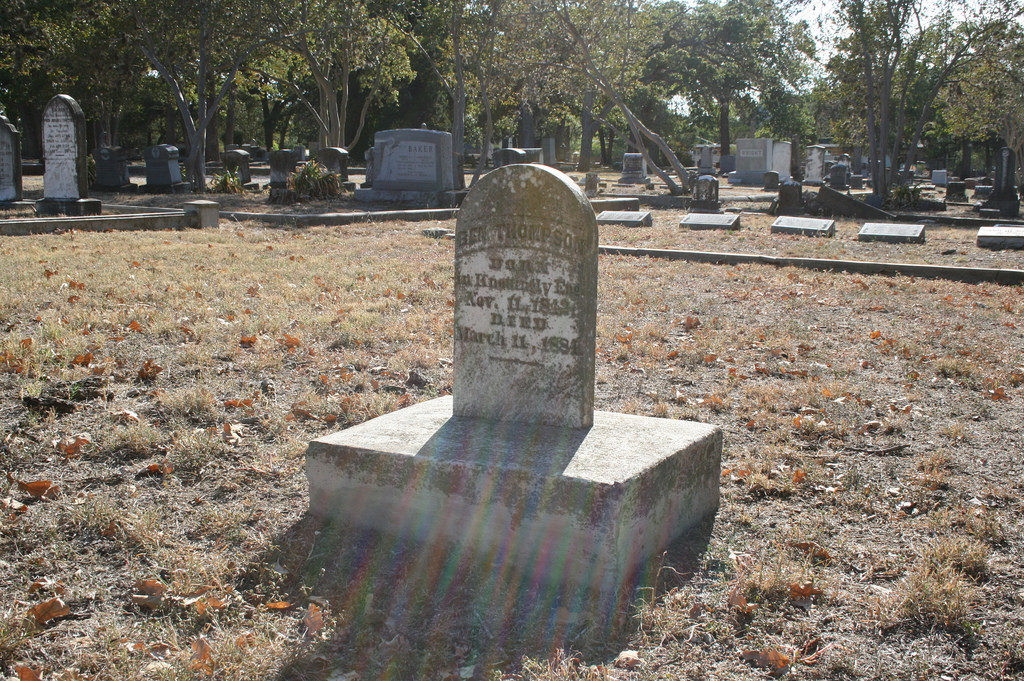It’s been an interesting autumn season out here at Chez Oddbooks and I am under the weather, so to speak. I hopefully will resume Halloween-y posts no later than Thursday. Until then, please feel free to share any creepy or Halloweenish story you think I’d like to hear. Any awesome horror novels or movies you’ve consumed lately? Did you listen to the Silencer video in today’s earlier entry and want to sue me for emotional damages? Comment away!
Author: anitadalton
Halloween 2017: Masks
It’s Halloween, so what better time to talk to you all about the masks or mask-like uses of make-up that annoy, upset or absolutely terrify me.
One of my earliest memories is of a television commercial promoting an Alice Cooper concert in Dallas. I must have been three or four at the time. I was absolutely terrified by his appearance, with the heavy eyeliner that appeared to be running down his face, the wild hair, the marks around his mouth that might have been blood for all I knew – our old television was in black and white.

My parents decided that the best way to help me overcome my fear of this horrible man on the TV was to force me to watch it every time it came on. My father would prevent me from running from the room when it aired, holding me there and telling me over and over that it was just a television commercial, it was just a man in make-up, that none of it could hurt me. It didn’t work. I screamed and cried and still he and my mother persisted, convinced they could reason with a frightened child. I had similar reactions to KISS, mostly Gene Simmons.
Interestingly, I am not particularly unnerved by clowns. I look at a clown, and I know it’s some asshole wearing a bunch of make-up and a wig and maybe some stupid clothes. I know what the intent is behind clown make-up – to delight or terrify. When I know the intent, it’s hard to be afraid, and that is where my parents, as well meaning as they were at the time, missed the mark. I didn’t need to know that it was a commercial and couldn’t hurt me. I needed to know why the man was dressed that way, what his intent was, what he planned to do in that get-up. And of course I could not express this so young and of course my parents had no idea what was at play in my terror. Variations of not knowing the reason behind the disguise fuels my adult uneasiness around masks, I think, though surely there are other explanations, from Jungian collective unconsciousness ruling my response to just plain jitters.
There are a lot of explanations as to why it is that people wear masks and costumes at Halloween and I am loath to discuss them because to do so means I have to cover every potential reason going back to early recorded history or someone will show up and leave a very long comment schooling me on Samhain-this and Pope-Boniface-that and how it’s racist for a white woman even to say Dia de los Muertos, let alone discuss the purpose behind sugar skull make-up. But this is a time of the year that makes a woman who finds the purpose behind masks very important somewhat uneasy. And perversely, because it makes me uneasy, I expose myself to it in ways that make me even more unnerved. But I can’t seem to avoid it, and since I can’t stop poking at this canker sore in my psyche, I’ve decided to drag you all down with me.
Halloween 2017: Corn Hill Cemetery
When Mr. OTC first learned about the Corn Hill Cemetery, the message board included some geographic coordinates and nary a mention that there was also a New Corn Hill adjacent to “old” Corn Hill. The geographical coordinates were only marginally more accurate than closing our eyes and smelling our way there, so it took us a while to find the Corn Hill Cemetery. Before we came close to our final destination, we found the Catholic cemetery in New Corn Hill, a herd of longhorns, a five-grave cemetery in the middle of a cornfield, a cemetery in someone’s front yard in Weir which is a completely different city, and eventually we found Corn Hill.
The cemetery was presented online as a cemetery in a ghost town. Really, it’s an active cemetery in a town that moved and got absorbed into another town. We were green in terms of such explorations at the time and now know the difference between “abandoned” and “located within a ghost town.” Ghost towns in Texas can be remarkably lively towns, teeny-tiny bucolic places among larger bucolic places. Corn Hill is such a ghost town and its cemetery, while very rural appearing with some very old graves (for Texas), is maintained and contain some recent burials.
I photographed this cemetery several years ago and didn’t intend to include it here for Halloween 2017, but decided to because of a bit of equipment failure that lost new photos. I also want to mention that this cemetery had some souls of the living variety when I photographed it. Some edgy teens were having a literal tea party at the edge of the cemetery where there were no graves. Because this is sort of a visually grim cemetery, they weren’t sitting on a blanket under a big tree or near a gazebo or benches. They were just out there in the corner of a chain link fence, quietly hanging out. They watched me for a while then realized I had no plans to hassle them and ignored me as I went about my business. They were still there when I left. If I were buried in a place like Corn Hill, I think I’d welcome well-behaved teens and their tea parties. I didn’t photograph them because they seemed like good kids, and also because if I had I might have upset them and a scene would have ensued. I don’t want to cause a scene among the dead.
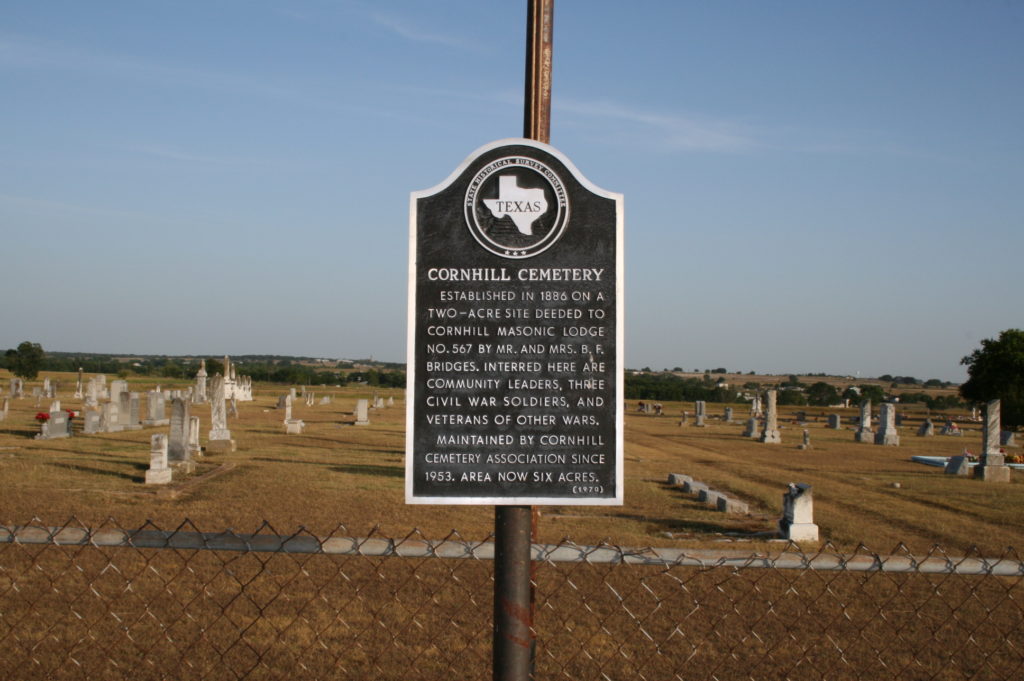
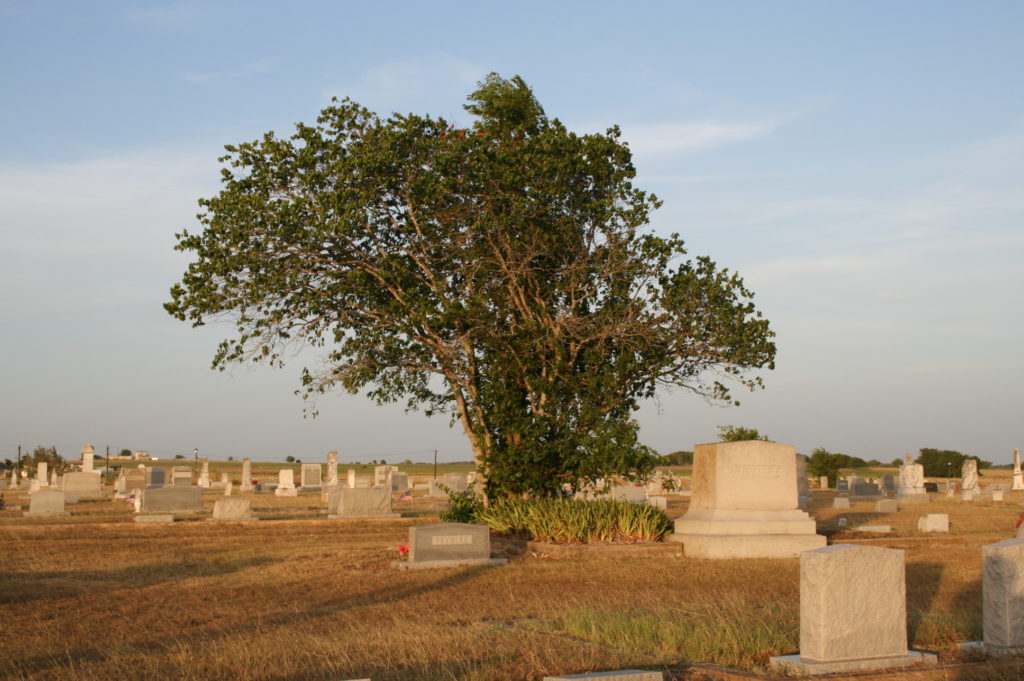
Halloween 2017: Abandoned Hotel in Corn Hill, Texas
The photos I am going to share in this Halloween 2017 entry are old, in Internet years. I had intended to share some photos I took over the last month depicting some dark Texas history as well as a lovely old cemetery up the road from my house, but I’ve had a significant equipment failure with my camera. I lack the vocabulary to explain what happened but from what I recall from the conversation I had with Mr. OTC, who is sometimes Mr. Tech-Support, a card got corrupted in my camera.
It’s really important to me to have an entry up every weekday in October. So I dug through my archives and found a couple of photo series that have not appeared online as much as some of my other photographs and with them I’ll create some photo essays of some of my interesting Texas crawls.
If you’re not from central Texas and know the name Jarrell, Texas, it is likely because of the massive tornados that struck the town in 1997, creating one of the most devastating natural disasters I’ve ever witnessed personally, being as landlocked as I am. Arguably the fires we get in these parts are worse but generally with fires, people are able to evacuate with some warning. The Jarrell tornados hit fast and with fury and destroyed so thoroughly that at least one family was wiped from the face of the earth. They were shredded in the winds and enough pieces were recovered to be able to legally declare people dead. Sturdy homes and trailers alike were leveled. We tell ourselves that our weather-predicting capabilities are far more sophisticated twenty years later but when a series of over 20 tornadoes is coming your way, there’s only so fast you can move to safety.
In fact, bizarre weather has made it hard to photograph some of the places I want to share here. The Columbus City Cemetery in Columbus, Texas, has some remarkable statues and a couple of pieces of interesting lore. One year massive fires kept me from going out there. This year Hurricane Harvey made a trip impossible. And the last two times I planned to go to a cemetery in Texas where supposedly there is a space alien buried, it snowed. Snow in Texas often borders on catastrophe and it is never particularly pretty more than two hours after it happens because it turns to slush, then into ice, and it’s a muddy, unappealing mess that results in more car crashes (when people like me try to drive on it) than snowmen.
But back to Jarrell, Texas. Years ago, Mr. OTC heard of a ghost town called Corn Hill that had a very interesting cemetery. When I hear “ghost town” I think of an abandoned western Main Street with boarded up shops and peeling clapboard houses. While there are a couple of abandoned buildings still standing, Corn Hill as a town relocated either to New Corn Hill (I am not making this up, I swear, and New Corn Hill boasts my favorite Texas cemetery to date) or was absorbed into Jarrell. The cause for Corn Hill dying is, of course, a railroad being laid a few miles in the wrong direction. At its peak, the town had around 350 citizens, a Mason lodge, a school, a post office, a stage stop and several churches. All that remains of Corn Hill are a few buildings and a cemetery. I will be sharing one of those buildings today and the cemetery tomorrow.
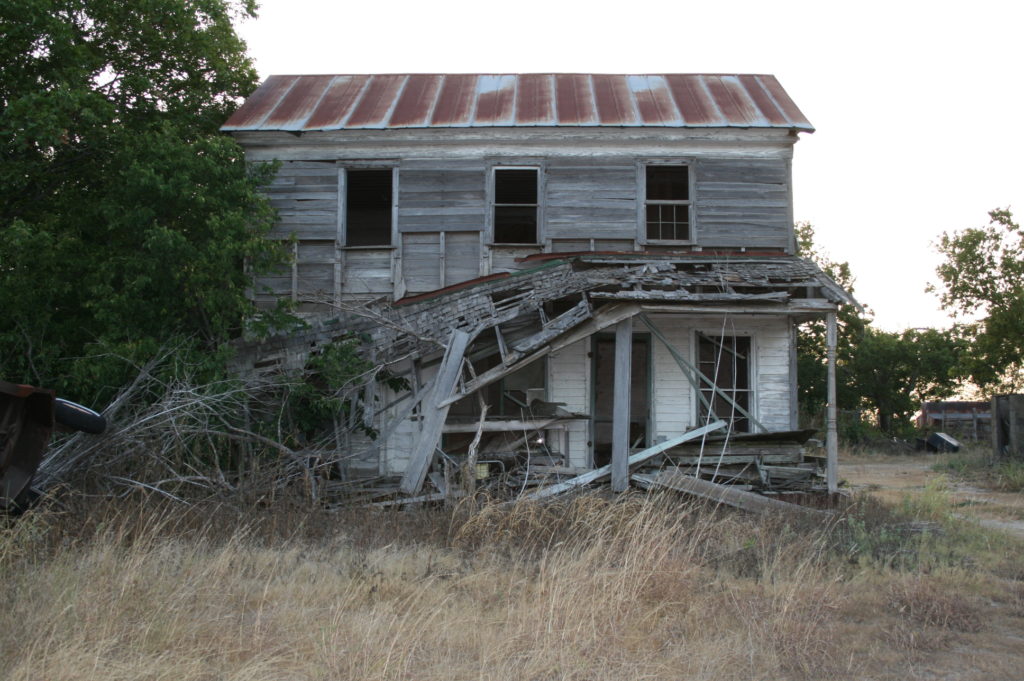
It’s amazing to me that this old house is still standing even after the tornadoes of 1997. I didn’t know the history of this place when I explored it. All I knew was that it looked interesting and that I have a complicated relationship with no trespassing signs. This building was once the hotel and the residence of John Shaver. Located just off I-35, this hotel and stage stop was built in the late 1870s.
But mostly the appeal of this building is how creepy it seemed initially. I guess plenty of fisherman use the “spike the head on a fence to skin the fish” method of descaling their daily catch but it will never not be creepy to see dead heads on barbed wire outside an abandoned house near dusk.
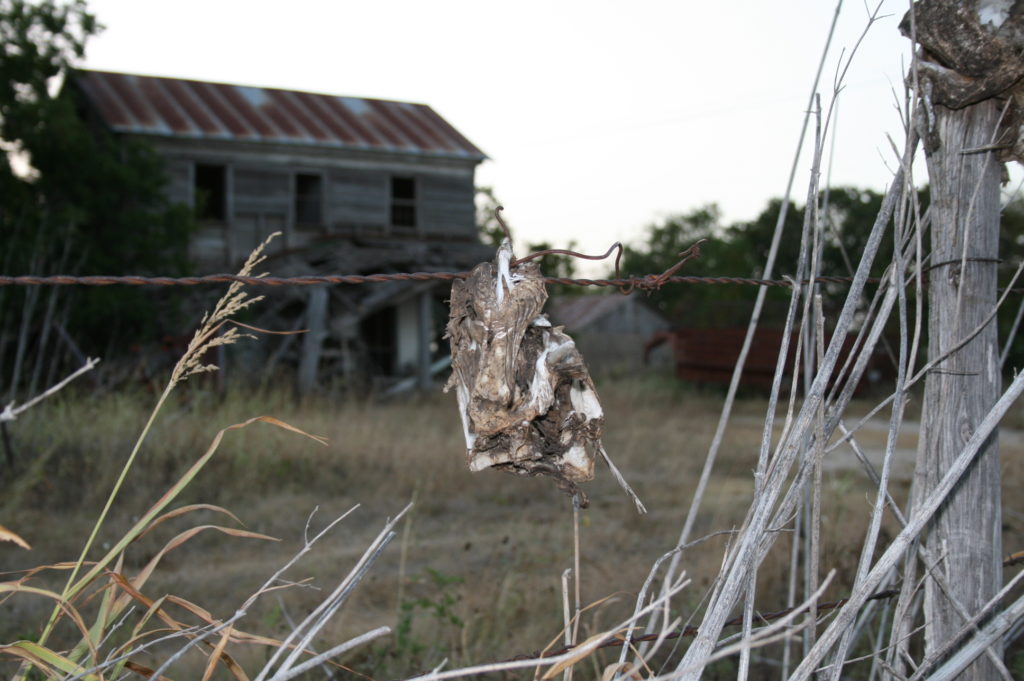
Halloween 2017: Psycho USA by Harold Schechter
Book: Psycho USA: Famous American Killers You Never Heard Of
Author: Harold Schechter
Type of Book: Non-fiction, true crime
Why Do I Consider This Book Odd: True crime will always have a tinge of the odd or bizarre about it for those of us who are definitely not the serial killer type.
Availability: Published by Ballantine Books in 2012, you can get a copy here:
Comments: Harold Schechter is one of my favorite true crime authors. I have several of his books covering the crimes of Ed Gein, H.H. Holmes, Jesse Pomeroy and others and one day hope to find myself with time to read some of his fiction. He writes in a manner that is both intelligent and accessible and manages to speak about the unspeakable without the bombast and disgust that I am sure would mar my writing were I ever to try to write about killers.
So given his skills, I should not have been so smug as to think this book had little to teach me. I’ve stated on this site before that up until 2000 or so, I knew about almost all serial killers, and I did know quite a bit. But I certainly knew far less than I thought I did because in this book of more obscure American killers, some of whom are serial killers or mass murderers, I only knew of three killers out of the thirty-one presented. Among poisoners, sex killers, lonely hearts murderers and family annihilators, I knew of the Smutty Nose Killer, an angry seaman who killed a house full of women for money; Carlyle Harris, a despicable seducer and poisoner; and William Edward Hickman, a kidnapper and mutilator. I had sort of heard of Andrew Kehoe, having come across his name in reference to school mass murderers, but had never read about him in any depth.
Since I am attempting to write quickly for Halloween, I’m going to write about the two murders I know best, and hope I can give justice to this compendium as I do it. A lot of the true crime encyclopedias out there are tiresome cash grabs, covering the same ground over and over and discussing intricate and fascinating murders in so little detail that the reader finds herself longing for text at least as comprehensive as Wikipedia. Not so with Schechter, and even if my discussion doesn’t resonate, you should look into him if his name is new to you. If it doesn’t resonate, it’s probably my fault.
Halloween 2017: Haunted Air by Ossian Brown
Book: Haunted Air
Author/Photo Collector: Ossian Brown, with introduction by David Lynch, epilogue by Geoff Cox
Type of Book: Non-fiction, photography collection
Why Do I Consider This Book Odd: The photographs themselves are odd and unsettling, but this book came with unexpected (and sort of gross) surprises. Plus this book links David Lynch and the dude from Coil together and that has some odd potential.
Availability: Published by Jonathan Cape in 2010, you can get a copy here:
If you live in the UK, it may be cheaper to get a copy here.
Comments: Sometimes the story of how I obtain a book is odd, though the story behind how I came to own this particular title is grimly predictable. Periodically, I will wake in the middle of the night and will take a sleeping pill to go back to sleep. This is problematic because I must take a Lunesta every night to sleep at all and am generally not really “awake” when I wake and take the second pill. Under the influence of double the dose I need to take, I will sometimes not go back to sleep. Sometimes I open my iPad and order strange fabric collections or, as you can guess, a load of books. I don’t know I’ve done this until I receive the shipment and wonder why it was sent and go online and see that I was shopping at four in the morning, ordering stuff from sites where my credit card is evidently stored in my account information.
And that’s how I came to own Haunted Air. Interestingly, I picked out books from my “wish list” so every book I ordered was something I wanted and none of them were too expensive, which was good since I ordered nine books. Since then I have kept my prescription anywhere other than the drawer of my bedside table and this hasn’t happened in about a year. I mention all of this because I personally find it creepy when I find evidence that I was moving around, engaging in activities I commonly associate with consciousness, when I was supposed to be sleeping. But given the popularity of hypnotics as sleep aids, this may not be creepy to others, especially Ambien users who wake to find they ate entire boxes of cereal with their hands or drove their car up to the Wag-a-Bag, executed a perfect parallel parking job, walked back home and went back to bed. Ordering books in an altered state of consciousness by most standards is vaguely creepy but largely benign.
That sort of describes this book, if you take out the “vaguely” and replace it with “rather.” This book really is rather creepy but largely benign, with any ill-intent coming from the reader herself. Ossian Brown has an impressive collection of old Halloween photos. The front page calls it “Hallowe’en” and the photos date from 1875-1955. I only mention the use of the precise but twee “Hallowe’en” because I really wanted to include this video wherein a Chloe Sevigny impersonator pronounces the word as written.
Back to the book. It occurs to me that the main reason this book is so creepy is because everyone takes about ten photos a day on their phone and so many of us are so very curated in how we appear, even when we disguise ourselves to celebrate pagan holidays. Endless Instagrams of intricate make-up jobs, exquisite costumes, spider-leg cupcakes straight from the latest Martha Stewart Living fall edition. We are hyper-aware of ourselves even when we appear candid. I personally won’t post photographs online if I find there is too much cat hair on the carpet or sofa, unless the purpose of the photo is to document the cat hair and even then I may use a filter.
So it’s unnerving to see people so nakedly and without guile wearing paper or burlap bags fashioned into masks. Church ladies with their hair up and their dresses buttoned to their necks wearing paper mache masks in scenes that are wholesome as wheat bread yet reminiscent of the set of The Texas Chainsaw Massacre. That sort of messy, archaic, unmatched, unincorporated Halloween is not a part of any American’s landscape any longer and the viewer of such photos can find herself in an uneasy place, understanding she is assigning a malignancy to plain-spun activities that was not intended by those in the photographs yet unable to stop herself from imagining someone in such a mask stabbing her to death.
Most of the photos in this collection are nightmare fuel. They are raw and primal, with a humble intensity that still surprises me when I revisit the photos. Here are some of the ones that set my teeth on edge.
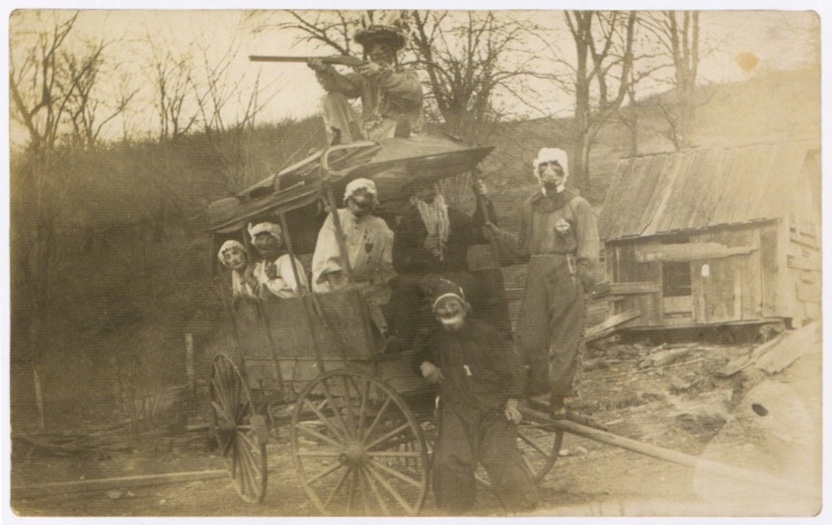
Halloween 2017: The Seventh Victim
As always, assume this discussion (of a film over seventy-years-old!!!) contains spoilers.
Every Halloween I always promise to myself that I will watch all the old horror films that I feel I should have watched. As a fan of the genre, I have watched precious few of the early horror films and even fewer of the 1960s and 1970s fare and am unable to hold my own in conversations about Hammer films. But I have to confess that I can never get through older films with legends like, say, Boris Karloff or Vincent Price, without wishing I was in space with two robots sitting next to me.
It was a simpler time. I know that. What frightened people eighty to ninety years ago is going to seem a bit quaint and possibly silly to a modern audience. I guess I am a result of growing up with John Carpenter’s Halloween films and the Friday the 13th and Hellraiser franchises, which are now cheesy in their own way, come to think of it. So I’ve been looking for an old horror film I can watch without mockery and I came close with The Seventh Victim.
I learned about The Seventh Victim watching a documentary about horror films – it may have been Nightmare in Red, White and Blue but it’s been a while. I filed it away mentally because it sounded interesting – the description of “a woman who dreams of death meets a woman desperate to live” or words to that effect plus a possible Satanic cult and of course I would eventually want to see this film.
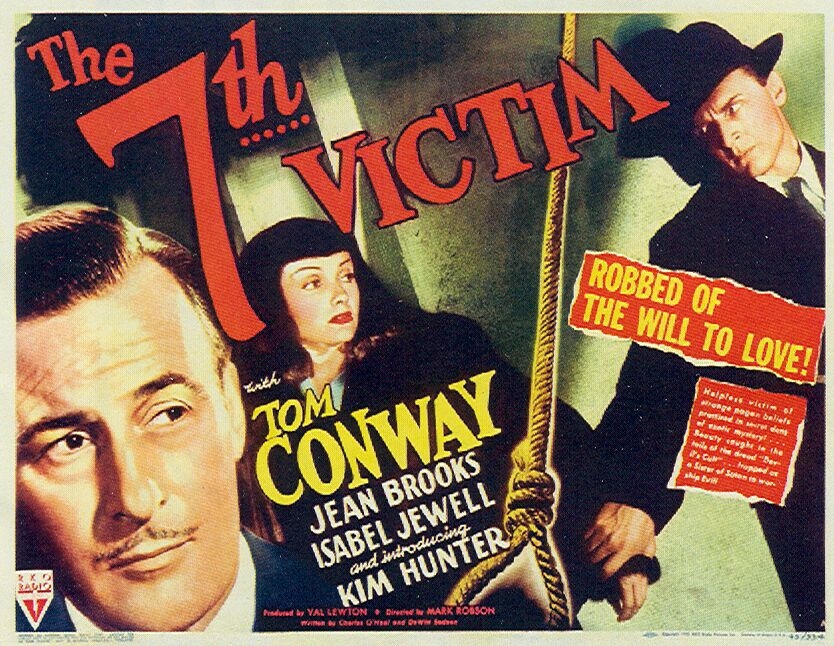
It wasn’t entirely as described but it was still interesting. Made in 1943, it presented a very calm and genteel look at human evil while using some tropes that I have come to associate with Hitchcock and Polanski. The femme fatale was surprisingly fragile, the teen sister looked like she was in her thirties, and all the men were sort of… dumb and/or sappy, but I think this film worked so well because it had elements of some of the more sophisticated horror movies, fare that genuinely unsettled me the first time I saw it. Christopher Lee as a vampire and Boris Karloff as a mummy never scared me, even as a kid, but Janet Lee in a shower and a cabal of Satanists in a swanky New York apartment seeking their heir did. Before I discuss this film, here’s a quick synopsis:
Mary Gibson, attending boarding school, finds out her older sister Jacqueline has gone missing. Jacqueline is her only family and has not paid Mary’s school fees so Mary decides she needs to try to find her sister. She travels to New York and discovers her sister had given away her cosmetic factory and salon to an employee called Esther Redi. She manages to trace the man whom she ultimately learns to be Jacqueline’s husband, Gregory Ward, and with him and a very sketchy psychiatrist, whom I think was the same psychiatrist in Cat People, and a dopey poet they manage to find Jacqueline. Jacqueline, who killed a private eye who was looking for her, is in hiding from both the law and a cabal of Satanists who think she has betrayed them by telling the psychiatrist, Dr. Judd, about them. Only six people have crossed this cult before and all were killed, and Jacqueline is to be their seventh victim, giving us the title of the film.
Though some of the characters were hokey – seriously someone needed to punch the stupid poet – this short, melodramatic little film was pretty good. Kim Hunter played Mary, the naive and innocent girl gone to the big city alone to find her sister. The terrible hair and fashion of the time made her look so much older than she was, but Hunter managed to pull off a neat balance between terrified virgin and intrepid girl scout on a mission. She stays in New York, Gregory Ward helps her get a job, she takes a room over an Italian restaurant (called Dante’s) and is pretty resilient without being too plucky to be unendurable.
Early on, Mary is helped by a private detective who realizes that Jacqueline is being held in a locked room at her salon, and she accompanies the PI to the salon at night and is too terrified to open the door herself. The PI reluctantly does it and she hovers in the shadows, frightened to her core, and later we learn that Jacqueline was indeed in that room and was convinced a member of the Satanic cult had come to kill her. The PI drops to the floor, having been stabbed with a pair of scissors, and Mary runs away, leaving him there. Initially, this scene seemed off, but later I realize how well it worked because what was Mary to do? He was dead, she couldn’t have removed him, and she had no idea how he came to be stabbed – was the killer still there? The fear and flight were the right reactions.
Gregory Ward, played by Hugh Beaumont (yep, Mr. Ward later became Ward Cleaver), knows he is being cuckolded by Dr. Judd, but is so taken with Jacqueline’s exquisite beauty and cluster-B tendencies that he supports her even on the run, though when he finds out she is a killer he encourages her to turn herself in. He also finds himself falling in love with Mary, probably because she is so uncomplicated. He abetted Jacqueline’s craziness to a shocking degree, and she was nuts, no two ways about it. Jacqueline was obsessed with death and suicide. Because she was so interested in death, she rented a room – over Dante’s restaurant – and the only things in the room were a noose and a chair. Gregory Ward kept up the rent on that room because he was besotted with what sounds like the mercurial nature of the personality disordered.
Interestingly, everyone felt Jacqueline was one of the most beautiful women they had ever seen. When we finally meet her, it’s a hoot. She’s a bog-standard proto-goth, down to the dyed-black hair and uneven baby bangs. Her affect is utterly flat, she seems to get by on her quirkiness (death obsessed, continually telling charming lies, being the sort who would get in deep with Greenwich Village Satanists and then rat them out in therapy), and given that this film is ostensibly about finding her it matters very little when she is found.
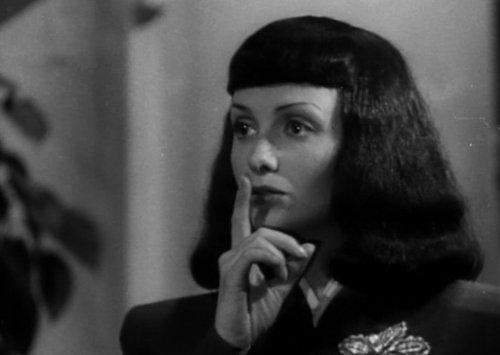
Dr. Judd, Gregory Ward, the poet whose name really doesn’t matter, and Mary finally track Jacqueline down and drag her back to Mary’s apartment to stay until Gregory can arrange a good time for her to turn herself in for killing the PI. But they don’t count on how intrepid the Satanists are. They find Jacqueline and escort her to their lair, which is an apartment and filled with a cast of characters we met earlier during a party (the woman who owns the apartment has one arm, inexplicably), and give her poison to drink.
But this cabal of Satanists are civilized. They will not kill her. They will just pressure her to commit suicide unless she refuses and then, maybe, they will kill her.
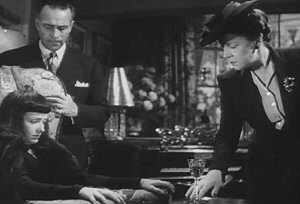
Unsure why this cabal exists – they seem to just like having parties and talking about being bad while not actually being bad – but among them are Esther Redi and an extremely emotional hairdresser who worked for the salon Jacqueline owned. When Jacqueline seems to be close to drinking the poison, the hairdresser loses it and breaks the glass and the cult sends sullen, affect-less Jacqueline on her way, only to follow her and try to kill her. Jacqueline gets away, desperate to live, and races back to Mary’s apartment above the restaurant.
It is here that she encounters the dying woman who wants to live. We had seen glimpses of Mimi, the coughing, dying wraith who lives in the building with the poet and Mary, but this is the first time she speaks. Jacqueline, so paranoid she sees this sick woman and is fearful she is part of the cult, demands to know who she is, and Mimi explains that she is dying and that she is tired of being sick. She wants to go out dancing and drinking and have fun, if only for one night, and then she might end it all. She will only kill herself because she so wants to live and is sick of not enjoying life as she slowly dies from her illness. Jacqueline, having refused to kill herself and having fought to remain alive, sees Mimi and rushes to her rented room and hangs herself. Don’t ask me why. Not the reaction I would have had. Conveniently her death clears the path for Mary and Gregory to be together, and Mimi does indeed dress up and have a lovely night on the town.
I was rather surprised by the way the Satanic cult was handled. The cult called themselves Palladists – presumably a name that nods to Pallas Athena – and looked like a 1940s bridge tournament was being held. The only one who seemed the least bit odd was the woman with one arm. Otherwise they seemed perfectly normal, got up to little that was evil – killing only those who threatened the cult and adhering to non-violence whenever possible – yet operated in such secrecy that one was certain that some horrible stuff had to have gone down at some point. One does not keep a 1940s exemplar of borderline personality disorder locked away in a room for months and later plan her death for squealing if one’s dopey cult does little more than hold interesting salon-style soirees and occasionally hail Satan.
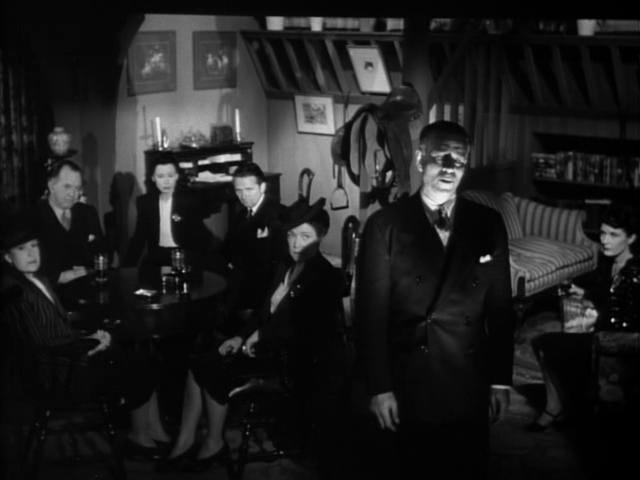
The cult reminded me a bit of the Satanists in Rosemary’s Baby, another New York Satanic cult that would not have raised an eyebrow initially, consisting as it did of daft old ladies like Ruth Gordon. Ultimately we saw what the cult that impregnated Rosemary Woodhouse was about, but in the 1940s I supposed filmmakers had less leeway to present Satanic evil to its fullest cinematic glory. In a way, if you know real life Satanists, the vast majority likely live lives not dissimilar to the lives of the Greenwich Village Satanists in The Seventh Victim, hosting tea parties and discussing the human will. Leave out the stalking and killing part and it was a surprisingly modern approach to Satanists. But since the stalking and murder were a part of this cult, it definitely harked back to Rosemary’s Baby – those who are genuinely evil in your midst may be the last people you would suspect.
Then there was the shower scene. Janet Leigh being stabbed to death in Psycho was more than fifteen years away from hitting the silver screen, but I’ve seen it, as have most horror fans, and that scene definitely colored how I viewed Mary’s shower scene. Mary had gotten her hair done at the salon her sister once owned, and had pumped the hairdresser for information about Esther Redi. Esther Redi finds out and goes to confront Mary. Mary lives in a single room over Dante’s Restaurant, and shares a bathroom with other tenants. She is in the shower, complete with shower cap to cover her freshly styled hair, when Esther Redi enters the bathroom, which presumably Mary forgot to lock.
We do not know much about this cabal of Satanists that Esther Redi belongs to, but it is never good when a young girl is caught at such a disadvantage. The shower curtain is clear so we can vaguely see Mary’s essential outline from Esther’s perspective. However, from Mary’s perspective, all we can see is Esther’s backlit shadow towering over her. But thankfully the Palladists are, at their core, gentle Satanists and Esther simply warns Mary away. But the menace was clear – Esther could get into the bathroom, and presumably into Mary’s room, and had no trouble sneaking up on the naive teen when she was at her most vulnerable.
The use of showers in horror films is a ringer – it’s almost too easy – young person, generally a woman, naked and defenseless, becomes an easy and titillating target for the killer/supernatural monster. But I note that in most “best shower scene in a horror movie lists,” the lists don’t include any films prior to 1960’s Psycho. Did this shower scene in the 1940s cause viewers the same apprehension it did me? Did that menacing silhouette have anything close to the same baggage then as it does post-Psycho? As I went looking for stills to demonstrate the scene, I found this snippet of the film on YouTube. The person behind this account clearly felt the same way I did.
This was not a terrifying film, but there were enough modern signifiers – a death-obsessed woman whose appearance was a precursor to more modern female death junkies/manic-depressive dream girls, Satanists that were not goat and baby sacrificing lunatics and judicious use of shower-menace – that it set far better with me than early monster movies and seriously hokey Hammer films (god, I want to enjoy Hammer films but they are just so purple and over the top and it makes me feel like a crappy horror fan that I sort of recoil when I hear the names Christopher Lee or Ingrid Pitt). I recommend watching it if you can find a copy. It’s not too hard, because you can stream it from Amazon.
If you watch it, let me know what you think. Feel free to make fun of me for not liking Hammer films. I’m used to it.
Halloween 2017: Ben Thompson’s Grave
Ben Thompson doesn’t have the level of posthumous fame as his exploits should have earned. I think it’s because he didn’t have a catchy nickname. In the early days of Texas statehood, among impulsive, gun-crazy men with a violent streak, he was first among equals. But fame is fickle and it’s hard to pin down why some gunslingers are well-remembered and why some become footnotes. In many regards, outside of Texas history buffs, Ben Thompson is a footnote.
Still, among lovers of Old West or Texas history, some of us do remember Ben Thompson and this is a perfect time of the year to share his story. He was a soldier and a lawman, but among Texas lawmen during the 1800s, it was not uncommon for lawmen to also be criminals, and Thompson was definitely a criminal, and a violent one at that. So violent was his life that some people interested in ghosts and the paranormal say the power of his character affects his final resting place.
Ben Thompson was like many of the wild men who made Texas their home – he was a jack of all trades before he found his niche as a gunslinger. Born in England in 1843, his family emigrated to Texas in 1851. In his teens, he worked as a printer’s apprentice and in 1859 he went to New Orleans to work as a bookbinder. It was in New Orleans that the man he was to become showed himself when he killed a man whom he claimed was abusing a woman. Stabbed him to death. He was fifteen or sixteen when this happened.
He served in the Civil War, fighting with the Confederates, but the battles he fought didn’t quell his love of guns and rough justice because after he returned to Austin he shot and killed a man during an argument over a mule. A mule. Seriously. And since the mule was technically Army property, Thompson was arrested. That didn’t slow him down though because he busted out of prison and fled to Mexico where he joined Maximillian’s forces until the good emperor lost the war in 1867. Clearly a man unable to function outside of conflict, Thompson returned to Austin and promptly shot his brother-in-law for abusing Thompson’s wife. Oh yeah, Thompson got married during his stint in the Civil War. The civilizing effects of marriage didn’t really take with him.
So, Thompson was tried and sent to prison in Huntsville, and this time he was unable to break out. He served two years of his four year sentence until pardoned by President Grant. Once free he headed up to Abilene, Kansas with his family and opened a prosperous saloon with an old Army buddy, Philip Coe, and seemed to be doing reasonably well. That changed when Thompson was in a terrible buggy accident that injured him, his son and his wife, who lost an arm. While Thompson was recovering from the accident, Coe went and got himself shot by Marshal “Wild Bill” Hickok.
By any measure Abilene of the early 1870s was a tough town, and its city marshal – James B. (Wild Bill) Hickok – was up to the challenge of taming its rowdy visitors. Although there may have been many reasons that Hickok and Philip Coe did not care for each other, it is likely that the basis for their dislike was a woman they both cherished. Apparently she chose the gambler over the lawman and was going to leave town with Coe – or so she thought. During the evening of October 5, 1871, Hickok shot Coe, who had been firing his pistol into the evening air on a street in Abilene. Tragically, in the confusion of the shots taken at Coe, Hickok also shot and killed his deputy. (Texas Cemeteries, Harvey)
After that, Abilene, Kansas was tired of Hickok and all the cattle drivers who passed through, making trouble at the drinking and gambling establishments, so they relieved Hickok of his duty and banned undesirables from entering or remaining in the city. That included Thompson so he went to Ellsworth, Kansas and began his time as a professional gambler. Interestingly, it was in Ellsworth that Thompson encountered another name we all remember more than poor Ben:
After the shooting of Coe, Ben Thompson left town for Ellsworth, Kansas, where he met Wyatt Earp in one of the Old West’s classic “in the streets” confrontations. Looking down the barrel of Earp’s gun, Thompson backed down and soon left Ellsworth for the Texas Panhandle. There Thompson would meet and, in the ensuing years, form a life-long friendship with Bat Masterson. (Texas Cemeteries, Harvey)
Interestingly, Thompson’s brother shot and killed the Ellsworth, Kansas sheriff and fled. A couple of years later he stood trial and was acquitted – the Thompson family seemed to be able to avoid the worst penalties for their impulsive and criminal natures, but so did a lot of men during that time. Rustle some cattle and you’d hang immediately if caught but shoot a sheriff and people could understand how the sheriff may have had it coming.
From 1874 to 1879, Thompson made his living as a professional gambler, traveling around various Texas cities, and of course he got into trouble as he did it. On Christmas Day, 1876, a fight broke out in the Austin Theater. Thompson, seeing a friend was causing the commotion, decided to help his friend out and jumped into the fray. When the theater owner emerged with a rifle and shot at Thompson, Thompson returned fire and killed him in three shots. It was determined later that Thompson had killed in self-defense.
Looking for quick money in the Colorado silver mines, Thompson went west and while there teamed up with his friend, Bat Masterson, who had assembled a team of hired guns to work for Kansas-based railroads that were embroiled in a right of way dispute with Colorado railroads. Thompson was well-paid for his efforts so he returned to Austin and opened a gambling saloon that he called the Iron Front Saloon. Here’s where it gets kind of funny: Ben Thompson was scrupulously honest in the way he ran his gambling tables and earned the respect of Austin citizens as being an honest man, so honest that the citizens in Austin elected him to be city marshal, not once, but twice. And the hell of it is, he was an honest man. He just liked shooting people. So why not have an honest shooter serve in law enforcement?
And it was a pretty good decision – plenty of people thought Ben Thompson was the best marshal Austin ever had. But rest assured he didn’t stop killing people. In 1882, Thompson visited the Vaudeville Theater in San Antonio and felt that the card tables at the establishment might not meet his level of scrupulous honesty and shot the theater owner, Jack Harris, to death. He was indicted for murder and resigned as marshal and it will surprise no one that he was acquitted of murder. Presumably the theater owner had it coming. Thompson returned to Austin and was given a hero’s welcome
Now, you and I, if we shot a popular entertainment establishment owner to death, we might be emboldened a bit if we returned home to the 1880s version of a ticker tape parade, but it takes a really bold person to return to the scene of the crime. Thompson went back to the Vaudeville Theater in 1884. He and his friend, John King Fisher, one helluva gunslinger in his own right, sauntered into San Antonio like they owned the place and news of their arrival spread quickly.
What happened inside the Vaudeville Theater depends on the sources. Some say that within minutes of entering the saloon area of the Vaudeville Theater, they were both ambushed and shot from behind. That’s some cowardly crap right there but, it must be said, that there would have been little chance for anyone to kill him in a straightforward gunfight. But other sources indicate that perhaps Thompson pushed things too far. He had already run into some of Jack Harris’ business partners inside the Vaudeville Theater, but stayed for the show and pressed his luck in the saloon
Thompson and Fisher had been drinking heavily in the saloon. Inside, Simms, Foster and three confederates were waiting. When the subject of the murder of Jack Harris came up, Fisher wanted to leave. But Thompson pushed on, eventually slapping Foster and putting a pistol in the saloon owner’s mouth. Almost immediately shooting broke the tension and silence of the room. As the smoke cleared, both Thompson and Fisher lay dead on the floor. Fisher had never drawn a gun, and Thompson managed but a single shot. Yet the bodies of the outlaw lawmen had nine and thirteen wounds, respectively. Ironically, a coroner’s jury in San Antonio ruled the killings self-defense. (Texas Cemeteries, Harvey)
Legends of the ambush grew far outside of the reality of what really happened. Texas history junkies talk of how it was that Ben Thompson killed six of the men who ambushed him with a single six-shooter and hit them each square like ducks in a carnival shooting game. The reality is that even in the scenario where he pressed his luck, he barely knew what hit him. I bet he’d have liked the way his own murder played out in terms of the myths that arose around him. But no one was ever charged with killing him, and his body was shipped back to Austin. He’s buried in Austin’s Oakwood Cemetery.
I first heard about Ben Thompson from a ghost hunter. I don’t hunt for ghosts, but I do like looking into ghost legends, and ghost hunters can be really helpful in finding out interesting stories. The lady I met told me that it was impossible to take a good photo of Ben Thompson’s gravestone because he hates the stone that was put on his resting place because it isn’t the one he won in a card game, so he makes sure all the photos people take are marred in some manner.
Bear with me, this story has some merit. The late Charley Eckhardt wrote up a lot of what he knew about some of the better and more interesting Texas legends and he wrote a short article about how it was that Ben Thompson won his tombstone in a card game. One night a tombstone salesman named Luke Watts played poker at a table at Iron Front Saloon and it just so happened that Ben Thompson was playing that night at that table as well. Watts tried to sell Ben Thompson a tombstone, but Thompson didn’t seem too interested. But when Watts had lost every penny in his pocket, Thompson’s demeanor changed.
Watts was not as good a poker player as he thought he was, and sometime after midnight he announced that he was cleaned out and was leaving the game. Thompson asked him how much his tombstones were worth. “It depends on what kind it is,” Watts replied.
Thompson said he wanted the best tombstone Watts had. Watts told him he had a fine marble stone that was worth $200. Thompson told him to bring it up and put it in the game. Thompson would accept it in lieu of $200 cash. The game began again and Thompson won the tombstone. Watts suggested that he carve at least Thompson’s name and date of birth on it, but Thompson said no. The stone sat in the poker room in the Iron Front for a few months, until Thompson ordered it moved to the basement.
Not long after this Ben Thompson died in the ambush in San Antonio, but according to Eckhardt his resting place in Oakwood Cemetery lacked a headstone until 1925, and that the tombstone he won remained in the basement of the Iron Front Saloon until it was demolished. Eckhardt wasn’t certain if the stone that was eventually placed on his grave was the stone he won in the card game.
I don’t know one rock from another but the stone that marks Ben Thompson’s resting place does not look like it’s fine marble and I don’t think that anyone was too pressed to rescue a slab of marble from the basement of a saloon marked for demolition.
Oakwood Cemetery is a favorite of mine and many others in the area. I spent a lot of time there searching for the burial places of the victims of the Servant Girl Annihilator, and while I was there years ago, I remembered that legend the ghost hunter told me and I took a photo of Ben Thompson’s gravestone.
And there you go. Maybe Ben really is angry about his stone and interferes with good pictures.
Join me under the cut as I behave like the killjoy I so often am.
Halloween 2017: Curve
This next offering in Halloween 2017 is not a traditional horror film, nor is it particularly Halloween-y. It, is, however, utterly frightening. This little ten minute film perfectly encapsulates what it must feel like to be doomed with no chance of reprieve, yet unable to let go of the very human need to keep fighting even when you know that all your effort may well come to nothing. I’ve watched this several times but each time I still feel the same tension, the same gritty fear as I imagine myself in the protagonist’s place. It’s been a long while since a horror film of any sort has left me this rattled.
Halloween 2017: It Comes at Night
This film was absolutely not what I was expecting. I tend to ignore book and film reviews before I consume media so it’s not uncommon that I find myself surprised when I finally watch the movie or read the book. But even with that in mind, this film was still surprising to me. When I see a title like “It Comes at Night” I have some expectations. Like a monster or killer or band of roving post-apocalyptic warriors literally coming at night, attacking the protagonists, creating the violent tension that makes horror films worth watching.
I felt let down by this film, and though that opinion has changed a bit, I still think this film has a core of dishonesty that ensures that the viewer can never know for sure what caused the events to unfold as they did. Which is fine in a way – nothing in the rule book says horror films have to be easy to parse out. My adoration of It Follows should show that I don’t mind doing the work necessary to figure out what is going on with a film. Sometimes half the fun comes from piecing together the details and clues so that we understand the filmmaker’s intent. That fun fades when a film that has only six characters and takes place mostly inside a single home muddies the plot line with so many dream sequences and Macguffins that the viewer will never be able to understand exactly what happened.
And I must say that even though I find this film to be dishonest, it still comes no where close to being as dishonest as the most dishonest horror film of all time, High Tension. I genuinely do not know how anyone could praise that film after viewing the last ten minutes. The ending shows that the entirety of the action up to that point could not have happened as presented, that literally the entire movie’s sequence of action could not possibly have occurred as the blonde heroine presents the action and experiences it, and therefore the film deliberately misrepresented everything that happened in order to achieve a GOTCHA ending. But the film likely still gets views because the action up until the directors shot us the middle finger was excellent and the lead actress was very effective in the role. While the actors in It Comes at Night do a fine job, the film is very static, with very few thrills. I guess if a film is going to dishonest, it needs to go big or go home..
Above the cut, I want to tell you that the actors did a fine job with the material in It Comes at Night, that the bulk of the film works on a very basic level, and that there are worse ways you can spend an hour and a half of your time. I’m telling you this above the cut because below the cut I will be utterly spoiling the film. If you want to take my reaction and run with it, now is the time to stop reading. For those who have seen the film and want to discuss it with me or those who don’t care about spoilers, let’s dissect this little film.
